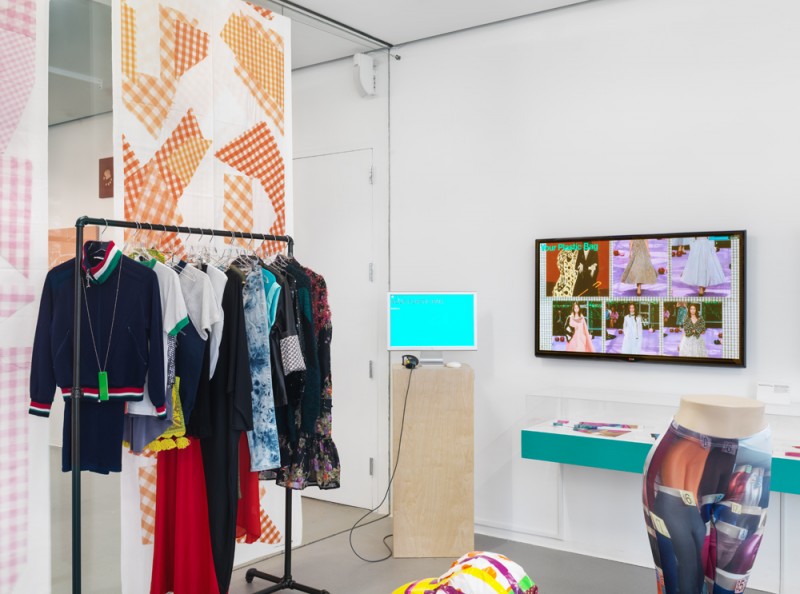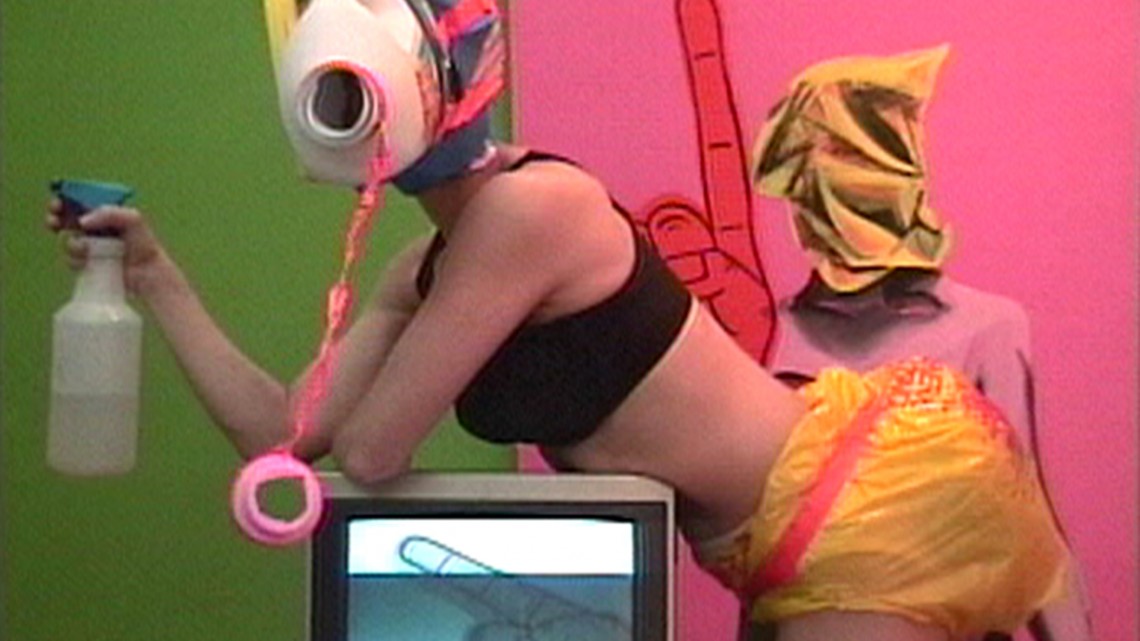Cheryl Donegan: Scenes + Commercials
New Museum
235 Bowery New York, NY 10002
January 20 – April 10, 2016
The artist Cheryl Donegan became known for her low-tech, gestural video works during the early 1990s. In Kiss My Royal Irish Ass (1992), she paints green shamrocks by sitting in paint then sitting on canvases. At the end of it, she sits in a chair and drinks a soda. Her early works were parodies of this kind, poking fun not only at the aesthetics of MTV music videos, but also the physical and figurative functions of art history.
Donegan is a trained painter, and her first videos were done with no editing—the music from a boombox playing live in her studio. Her most famous work is a video called Head (1993) that was made early in her career, which shows her suggestively drinking out of the punctured spout of a lime-green plastic container, periodically spitting it back into the mouth at the top of the container, then, in a live painting climax, spits it onto the peach-flesh backdrop. She said in a 2014 interview with Bomb that she still found it “funny and still audacious and sometimes a little embarrassing and sometimes a little liberated.” It was an art world hit of lo-fi and feminism.

Cheryl Donegan, Scenes + Commercials, Installation view, 2016. Courtesy the artist and New Museum.
However—as she says in the audio tour guide for her exhibition at New Museum, Scenes + Commercials—she became disenchanted with the idea of starring in her own works, and started making more abstract videos, while still working in her mix of painting and sculpture. The exhibition does not contain Head, what some might assert is her definitive work. Instead, the exhibition contains works from the span of Donegan’s career—including Kiss My Royal Irish Ass, as well as early studies for her videos, acrylic paintings from the early 2000s, and works centered on Gingham patterns, a favorite motif of Donegan’s, which glow fluorescently on the walls and tell of an interest in grids both stable and not. Donegan also set up a “Concept Store” in the former Resource Center of the New Museum’s 5th floor, which contains retail-style displays of leggings with flashy graphics and a rack of things she bought on eBay that you can scan at a point-of-sale computer to see its origins.

Cheryl Donegan, Untitled (two rose ginghams), 2012. Fabric on medium-density fiberboard, 20 x 26 in (50.8 x 66 cm). Courtesy the artist and David Shelton Gallery, Houston
Regarding the title, Scenes + Commercials, Donegan says it’s meant to imply that there is “the drama you came to see, and also the commercials, the things that are in between, and how both are really affecting your experience”[1] Just as in real life, it can be unclear what’s the drama, and what’s the commercial. Though it would appear that the videos are the dramas, they themselves are a microcosm of an American, late capitalist life, containing all the trimmings of material, rehearsal, drama, and commercial content. The paintings too are a microcosm of this kind.
Her works are critiques, refusals, and appraisals of gendered labor, the types where the body is the target and site of consumption and production, including housework and fashion as much as art making. Re-employing the strategies of museum presentation, Scenes + Commercials is a solid retrospective, but in terms of its retail display method of the Concept Store, it feels a bit like stepping into an American Apparel.

Cheryl Donegan, Scenes + Commercials, Installation view, 2016. Courtesy the artist and New Museum.
Which isn’t necessarily a bad thing—the show is revealing of middlebrow aesthetics, their evolution in the ‘90s and ‘00s, and how its tropes filter into culture at the levels of mass consumer, high art, and pop. Perhaps it’s my own inability to discern between the methods that Donegan employs for the Concept Store that’s part of the show, but the whole retail-in-a-museum installation feels like a tired experience at this cultural, post-Internet moment. However, the mix of works in the main part of the exhibition is a stimulating look at an artist’s traversal of the middle ground between high and low, between art and the everyday.
In Scenes + Commercials, the body is not only presented as a means for expression and an art making tool, but a thing that synthesizes with consumer objects and materials The slapstick quality of bleach bottles and coolers and coupons belies a deep consideration of how things and brands merge into our lives, exploring a post-Warholian world where we recognize everyday objects—as well as works of fine art—as the commodities that they are.

Cheryl Donegan, Scenes + Commercials, Installation view, 2016. Courtesy the artist and New Museum.
—
[1] Cheryl Donegan, Scenes + Commercials audio guide



